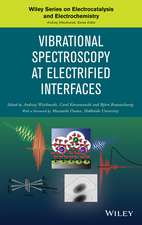Spectroscopy: Volume Three
Editat de B. Straughanen Limba Engleză Paperback – 10 iun 1976
Preț: 698.80 lei
Preț vechi: 822.12 lei
-15% Nou
Puncte Express: 1048
Preț estimativ în valută:
133.73€ • 145.21$ • 112.33£
133.73€ • 145.21$ • 112.33£
Carte tipărită la comandă
Livrare economică 23 aprilie-07 mai
Preluare comenzi: 021 569.72.76
Specificații
ISBN-13: 9780412133909
ISBN-10: 0412133903
Pagini: 324
Ilustrații: X, 324 p.
Dimensiuni: 155 x 235 x 18 mm
Greutate: 0.47 kg
Ediția:Revised
Editura: SPRINGER NETHERLANDS
Colecția Springer
Locul publicării:Dordrecht, Netherlands
ISBN-10: 0412133903
Pagini: 324
Ilustrații: X, 324 p.
Dimensiuni: 155 x 235 x 18 mm
Greutate: 0.47 kg
Ediția:Revised
Editura: SPRINGER NETHERLANDS
Colecția Springer
Locul publicării:Dordrecht, Netherlands
Public țintă
ResearchCuprins
1 Molecular Quantum Numbers of Diatomic Molecules.- 1.1 Formation of molecular quantum numbers.- 1.2 ‘Scripts’ giving information on the wavefunction symmetry of diatomic molecules.- 1.3 Correlation between atomic and molecular states.- 1.4 Coupling of angular momenta.- 1.5 Selection roles of diatomic molecules.- 1.6 A doubling.- 1.7 c and d classification of rotational levels.- References.- 2 Electronic Spectra of Gaseous Diatomic Molecules.- 2.l Introduction.- 2.2 Instrumentation.- 2.3 Electronic excitation of diatomic species.- 2.4 Electronic spectra of diatomic species in flames.- 2.5 More recent studies of electronic spectra.- References.- 3 Dissociation Energies of Diatomic Molecules.- 3.l Introduction.- 3.2 Evaluation of D by band convergence method.- 3.3 Evaluation of De by extrapolation to convergence limits.- 3.4 Evaluation of D by atomic fluorescence method.- 3.5 Predissociation and its use in evaluating D.- 3.6 Conclusions on the determination of dissociation energies of diatomic molecules.- 3.7 Recent dissociation energy studies for diatomic molecules.- References.- 4 Electronic Spectra of Polyatomic Molecules.- 4.1 Introduction.- 4.2 Absorption of light by a medium.- 4.3 Instrumentation.- 4.4 The electronic states of polyatomic molecules.- 4.5 Interpretation of the absorption spectra of organic compounds.- 4.6 Selection rules for electronic transitions.- 4.7 Electronic spectra of transition metal complexes.- 4.8 Charge transfer spectra.- 4.9 Electronic spectra of short lived species.- 4.10 Some applications to kinetics.- 4.11 Optical rotatory dispersion and circular dichroism.- References.- 5 Fluorescence and Phosphorescence Spectroscopy.- 5.1 Introduction.- 5.2 Fluorescence.- 5.3 Phosphorescence.- 5.4 Excitation spectra.- 5.5 Experimental methods.-5.6 Applications of fluroescence and phosphorescence.- References.- 6 Astrochemistry.- 6.1 Introduction and instrumentation.- 6.2 The Doppler effect.- 6.3 Planetary atmospheres.- 6.4 Spectra of nebulae and forbidden transitions.- 6.5 Spectra of comets.- 6.6 Stellar spectra.- 6.7 Spectral studies of the interstellar medium.- 6.8 Pulsars and quasars.- 6.9 Space probes in the mid-seventies.- References.- 7 Photoelectron Spectroscopy.- 7.1 Introduction.- 7.2 Instrumentation.- 7.3 Chemical information from photoelectron spectroscopy.- 7.4 Solid state surface studies.- 7.5 Surface charging and the calibration problem.- 7.6 Photoelectron intensities.- 7.7 Valence energy level studies.- 7.8 Additional structure in U.V. photoelectron spectra.- 7.9 Core energy level studies.- 7.10 Additional structure in X-ray photoelectron spectra.- References.- A APPENDIX.- A.1 Absorption and emission of radiation.- A.2 Energy levels of a linear rigid motor.- A.3 Selection rules for the linear rigid motor.- A.4 Energy levels of a harmonic oscillator.- A.5 Calculation of the vibrational eigen functions for a diatomic molecule.- A.6 Selection rules for changes in vibration quantum numbers.- A.7 Absolute intensities of absorptions.- A.8 Electronic transition probability and spectral intensity.










